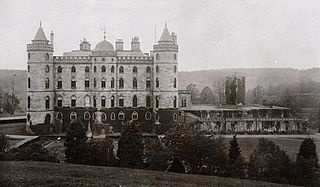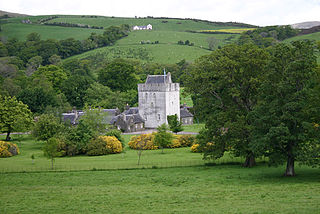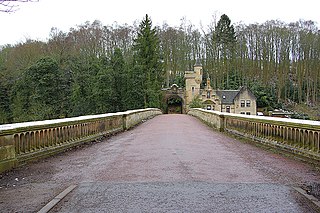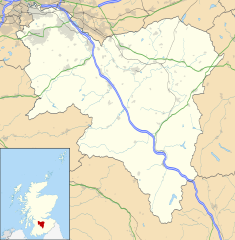
Cadzow Castle, now in ruins, was constructed between 1500 and 1550 at a site one mile south-east of the centre of Hamilton, South Lanarkshire, Scotland. The earlier medieval settlement of Hamilton was formerly known as Cadzow or Cadyou, until it was renamed in 1455 in honour of James Hamilton, 1st Lord Hamilton. The castle sits above a gorge overlooking the Avon Water in what is now Chatelherault Country Park, but was previously the hunting and pleasure grounds of the Duke of Hamilton's estate of Hamilton Palace - this area being known as Hamilton High Parks. The ruin is a Scheduled Ancient Monument.

Dalmeny House is a Gothic revival mansion located in an estate close to Dalmeny on the Firth of Forth, to the north-west of Edinburgh, Scotland. It was designed by William Wilkins, and completed in 1817. Dalmeny House is the home of the Earl and Countess of Rosebery. The house was the first in Scotland to be built in the Tudor Revival style. It provided more comfortable accommodation than the former ancestral residence, Barnbougle Castle, which still stands close by. Dalmeny today remains a private house, although it is open to the public during the summer months. The house is protected as a category A listed building, while the grounds are included in the Inventory of Gardens and Designed Landscapes in Scotland.

Bothwell is a conservation village in the South Lanarkshire council area of Scotland. It lies on the north bank of the River Clyde, adjacent to Uddingston and Hamilton, 9 miles (14 km) east-south-east of Glasgow city centre.

Overtoun House is a 19th-century country house and estate in West Dunbartonshire, Scotland. Situated on a hill overlooking the River Clyde, it is two kilometres (1.2 mi) north of the village of Milton and three kilometres (1.9 mi) east of the town of Dumbarton. The house, an example of Scottish Baronial architecture, was built in the 1860s, and was donated to the people of Dumbarton in 1938. It was subsequently a maternity hospital, and now houses a Christian centre. The house is protected as a category A listed building, while the grounds are included in the Inventory of Gardens and Designed Landscapes in Scotland. Landscape features include the Overtoun Bridge on the approach road, designed by H. E. Milner.

Crawford Castle, substantially in ruins, is located on the north bank of the River Clyde, around half a mile north of Crawford, South Lanarkshire, Scotland. The ruins stand on an earlier motte and bailey earthwork. The castle is also known as Lindsay Tower, after its former owners, the Lindsay family. The strategic location of the castle, at NS954213, guards the strategically important Mennock Pass from England into the upper Clyde Valley.
Baron Newlands, of Newlands and Barrofield in the County of the City of Glasgow and of Mauldslie Castle in the County of Lanark, was a title in the Peerage of the United Kingdom. It was created on 19 January 1898 for the soldier Sir William Hozier, 1st Baronet. He had already been created a baronet in the Baronetage of the United Kingdom in 1890. He was succeeded by his only son, the second Baron. He represented Lanarkshire South in the House of Commons and served as Lord-Lieutenant of Lanarkshire. Lord Newlands was childless and the titles became extinct on his death on 5 September 1929.

Douglas Castle was a stronghold of the Douglas family from medieval times to the 20th century. The first castle, erected in the 13th century, was destroyed and replaced several times until the 18th century when a large mansion house was built in its place. This too was demolished in 1938, and today only a single corner tower of the 17th-century castle remains. The castle was the former family seat of the Prime Minister, Sir Alec Douglas-Home. The castle was located around 1 kilometre (0.62 mi) north-east of the village of Douglas, South Lanarkshire, in south-west Scotland. The remains are protected as a category C listed building.

Kames Castle is a 16th-century tower house located on the shore of Kames Bay near Port Bannatyne, on the Isle of Bute, Scotland. The castle, which is set in 20 acres (81,000 m2) of planted grounds, includes a 2-acre (8,100 m2) 18th-century walled garden. It is extended through the addition of a range of stone cottages. The castle, cottages, walled garden and other estate buildings are category B listed buildings.

Brahan Castle was situated 3.5 miles (5.6 km) south-west of Dingwall, in Easter Ross, Scotland. The castle belonged to the Earls of Seaforth, chiefs of the Clan Mackenzie, who dominated the area.

Dalzell House is a historic house in Motherwell, North Lanarkshire, Scotland. It is located to the south of the town, on the north bank of the River Clyde. At its core is a 15th-century tower house, with extensive additions built during the 17th and 19th centuries. In the 1980s the house was restored and divided for sale as eighteen private apartments, while the surrounding Dalzell estate is now owned by North Lanarkshire Council. The house is protected as a Category A listed building, and the grounds are listed on the Inventory of Gardens and Designed Landscapes in Scotland.
William Wallace Hozier, 1st Baron Newlands, known as Sir William Hozier, Bt, between 1890 and 1898, was a Scottish soldier and businessman.

Lee Castle, also known as The Lee, is a castellated mansion in Auchenglen, a branch of the Clyde Valley in South Lanarkshire, Scotland. It is located 1.5 kilometres (0.93 mi) south of Braidwood, and 4 kilometres (2.5 mi) north-west of Lanark. Lee was the seat of the Lockharts of Lee from its establishment in the 13th century until 1919, though the present house is the result of rebuilding in the 19th century.

Ardgowan House is a late 18th-century mansion and estate on the Firth of Clyde near Inverkip, Scotland. Ardgowan is located in Inverclyde, in the former county of Renfrewshire. The Ardgowan estate has been held by the Stewart family since the early 15th century: towards the end of that century, their tower house Ardgowan Castle was built within the site of the previous Inverkip Castle fortress. The present house was erected in 1797 and completed in 1801 from designs by Cairncross. It is the seat of the Shaw Stewart baronets, currently Sir Ludovic Houston Shaw Stewart, 12th Baronet of Greenock and Blackhall.

The Clyde Valley Woodlands National Nature Reserve (NNR) comprises six separate woodland sites in the Clyde Valley region of South Lanarkshire, Scotland. These six sites are located along a 12 km section of the River Clyde and its tributaries, and lie close to built-up areas such as Hamilton and Lanark on the southern outskirts of Greater Glasgow. The sites can be easily accessed by about two million people living in the surrounding urban areas, making the reserve unique amongst Scotland's NNRs, most of which tend to be located in more remote areas. The six sites are:
Stonebyres was an estate and country house in Lanarkshire, Scotland, belonging to the Weir, or de Vere, family from earliest recorded history. The Weir-de Veres were a cadet branch of the Weir family of Blackwood but were a powerful and sometimes rival branch of the laird of Blackwood, head of Clan Weir. The laird of Stonebyres was often styled Baron Stonebyres.

Shewalton House and estate were composed of the 'Lands of Shewalton' and the laird's dwelling, originally a tower castle and later a mansion house on the River Irvine in the Shewalton area, two miles from Irvine and west of Drybridge village, East Ayrshire, Dundonald Parish, Scotland. In 1883 the Boyle's estate of Shewalton was 2,358 acres in extent in Ayrshire and was worth at that time £2,708 a year.

Sir Henry Montague Hozier was a British Army officer who became secretary of Lloyd's of London.

Mauldslie Bridge is a three-segmental-arch bridge in Dalserf, South Lanarkshire, Scotland. It crosses the River Clyde between the A72 road and the former location of Mauldslie Castle. Built in 1861, and now a Category A listed structure, the bridge is believed to be the work of David Bryce. Mauldslie Castle West Lodge and archway stands at the western end of the bridge. They are listed separately at Historic Environment Scotland.

Mauldslie Castle West Lodge is a 19th-century gatehouse in Dalserf, South Lanarkshire, Scotland. A Category A listed building, it was completed in 1861, believed to be the work of David Bryce.



















